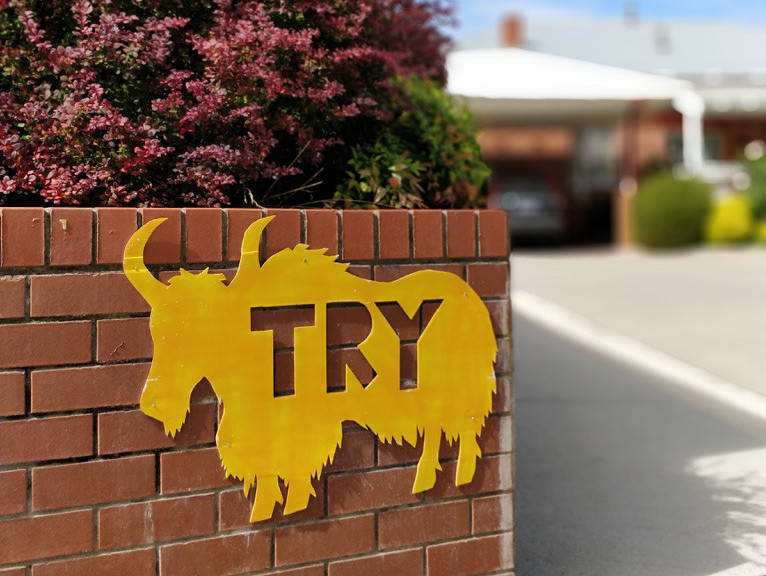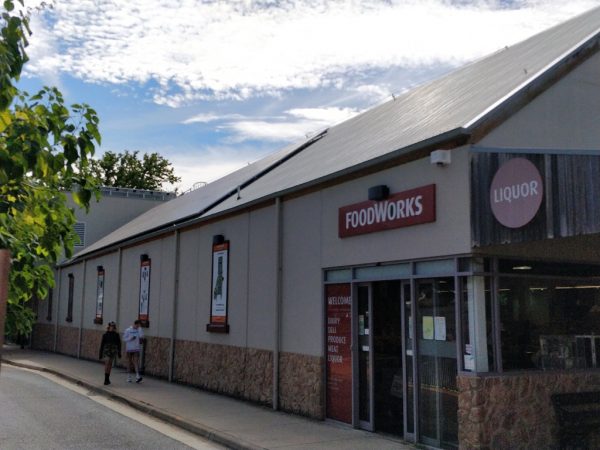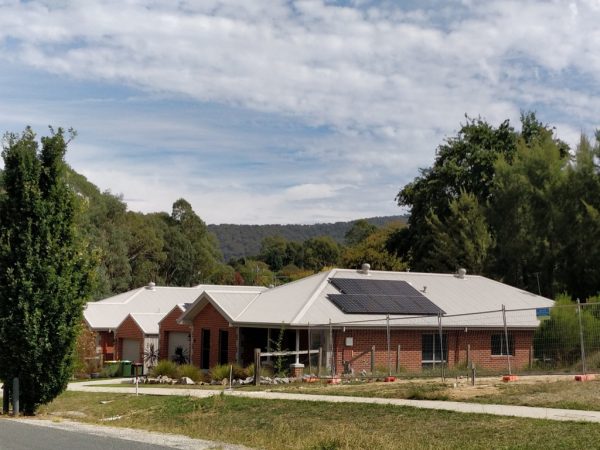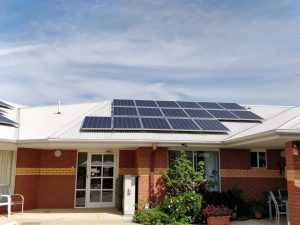In recent years the number of community owned renewable energy groups has grown rapidly. If the experience in the north-east of Victoria is any guide, their advent promises to not only provide cleaner power systems but also make the benefits available to everyone in those communities.

Driving around Yackandandah on a gloriously sunny Sunday morning, the sky is reflected in still ponds of black glass on every third or fourth building. They catch the eye in the hilly terrain the town is built on as the main road often overlooks the houses alongside it. Turning into a newer estate the old stone walls and established buildings give way to new houses, but here the glass panels inhabit almost every roof I pass.
I take a chance and knock on the door of a house clad in modern corrugated iron, with solid rammed earth walls and a yellow yak on the letter box with the letters ‘TRY’ in the centre of it’s body. A spry older gentleman with a tanned face answers the door. I ask him if it required a lot of thinking to join Totally Renewable Yackandandah or TRY, the local renewable energy group. Friendly eyes look at me, he solemnly places a hand on his chest and with a strong Dutch accent says only, “My heart.” After 30 years living in an energy efficient house at nearby Allans Flat and with a keen interest in sustainable design, Nico van Nouhuys and his wife didn’t require any convincing to join TRY when they moved into town. Their house is part of the 40% of dwellings in Yackandandah that already have solar panels, far above the national average that is variously quoted at between 20 and 25%. They, unlike a significant proportion of the Australian population, have the financial and physical resources to invest in renewable energy.
The small township of Yackandandah, with a population of just under 1000, is a vibrant community based in a dairy farming and forestry area but is also focussed on tourists and sustainability. Despite their size they hosted no less than the Federal Energy Minister, Josh Frydenberg, in March when he met with local renewable energy groups to promote funding initiatives by the Australian Renewable Energy Agency (ARENA). The meeting in Yackandandah was one of several organised by Independent MP Cathy McGowan AO to foster collaborations. Several north-east Victorian community renewable energy groups attended, including TRY and Renewable Albury Wodonga Energy (RAW Energy). The groups were looking to advance their existing projects and build regional collaborations, and in the process make renewable energy accessible to all sections of their communities, not just those that can afford to buy solar panels.
Community renewable energy refers to projects involving sustainable energy that are community owned or driven, with benefits flowing back to the community. Like many other community renewable energy groups TRY and RAW Energy were formed relatively recently, in 2014 and 2015 respectively. They are both intent on developing and advancing renewable energy projects, with TRY having the additional goal of seeking to power the entire town of Yackandandah with 100% renewable energy by 2022.
It’s an ambitious plan but one that is becoming more common, with at least two other “Totally Renewable” groups forming in towns in the area so far this year. Committing an entire town to using 100% renewable energy requires not only planning, drive and technical understanding, but also that everyone in the town is able to afford and access renewable energy. TRY volunteer Ben McGowan says of their strategy to facilitate access to renewable energy to 2200 local people, “Inclusivity, that’s a part of it, and equity as well – everyone should have access to renewable energy.” But for many people the cost of an average household-scale 4 or 5 kilowatt solar system at a cost of around $7500 is unaffordable, and then there are those that rent their house or live in apartments and cannot access renewable energy at all because they do not own their roof.
“… everyone should have access to renewable energy” – Ben McGowan, TRY
In the last half of 2017 over 13,000 Victorian customers were disconnected from their electricity supply for not paying their bills according to the Victorian Energy Market Update from the Essential Services Commission. However, this doesn’t include the approximately 35,000 additional energy customers that were experiencing difficulties paying their bills but were part of special hardship programs run by the retailers. They could not be disconnected but were still having significant difficulties paying their bills. Data from the Essential Services Commission is not broken down by geographical area, but an indication of the prevalence of energy hardship in north-east Victoria is given by the Victorian Energy and Water Ombudsman’s 2016-17 annual report. It listed Wodonga as one of the top three council areas, along with LaTrobe and Wangaratta, that have the highest rates of energy disconnection and water restrictions in the state.
At Birallee Park Neighbourhood House in Wodonga, chairperson Ed Foulston says they see a lot of people suffering financial hardship due to high energy bills. He says some people would like access to solar to reduce their power bills but because the property is rental, neither state or federal governments offer any assistance. He goes on, “If you own your home you can get RECS (Renewable Energy Certificates) or whatever to (help) put solar panels on etc but if you’re in rental accommodation then you can’t.” He says there are also obstacles for those in public housing provided by the Department of Health and Human Services (DHHS). He tells of one of his clients who has been in her home for 20 years, and is not looking to move, but the DHHS in Victoria do not support their clients putting solar panels on so she is unable to get any assistance. “They’re going to have to scrimp and save to put panels on, because they can see the benefit long term in regards to paying bills, but DHHS won’t help.”
“I can see that being a really unique opportunity for low income houses…” – Matthew Charles-Jones, TRY
TRY has a range of measures that allow participation at different levels that tackle issues such as these. They plan on developing a community energy retailer, so that renewable energy can be sold to anyone in the region, even those who are renting or can’t afford panels. A perpetual fund is already assisting businesses in Yackandandah to fund renewable energy and energy efficiency projects, while a partnership with WAW Credit Union provides ‘green’ loans to residents for environmentally sustainable projects. The proposed community energy retailer would also be expected to develop larger renewable energy installations in which residents could purchase single panels. In addition residents could enter into behind-the-meter agreements with independent retailers, where products are installed on the homeowner’s roof ‘behind’ their power meter where it connects to the grid, and effectively rent their roof space for someone else’s solar panels. As TRY’s co-chair Matthew Charles-Jones says, “I can see that being a really unique opportunity for low income houses or people who are experiencing hardship.”
Nearby in Wodonga, RAW Energy is also excited about possible future funding. They have developed a business case for a medium-scale solar farm and want to start the next phase. Co-founder Bobbi McKibbin says making the benefits of renewable energy available to everyone was a primary focus. From the start they asked themselves, “How can we deliver that power to those in the community that don’t have the opportunity to put solar on their roof?” They are collaborating with TRY and other local renewable energy groups to develop a regional community energy retailer and are considering a range of measures including energy efficiency and education programs. As well as assisting residents to save money, thus helping lower-income households, they see such programs as a sustainability measure that reduces excess or unnecessary power usage.
Recognising significant benefits in RAW Energy’s plans is Catherine Byrne, an emergency relief coordinator in Wodonga. In her work she deals with many people from lower-income households for whom any increase in energy prices is detrimental and says that when people come to her they are in crisis. She thinks that the ability for those people to access cheaper energy, or reduce their energy usage and thus reduce their power bills, is a great initiative. She also says it’s not just about the benefits that RAW Energy can provide for her clients, but how they can assist everyone in the community, “because even for our service to operate, as we’re a major food provider, the energy costs for us are ever increasing as well.” So the reduction in running costs for many community-based organisations would also be very valuable.
“… as we’re a major food provider, the energy costs for us are ever increasing as well.” – Catherine Byrne, emergency relief coordinator
This focus on providing benefits to all levels of the community is a feature of community renewable energy groups. Although the area of community renewable energy is relatively new in Australia, with little local research to explain the driving forces behind it, Annie McCabe at the University of Queensland is one of a small group of recent researchers who are looking at it. She has seen the rapid growth in community renewable energy groups since she started her PhD in 2014. She says many community energy groups in Australia are started by people who have travelled and seen the successful models in other countries, such as Germany and Denmark, and want to adopt these ideas back home. “In the last four years of my thesis it’s grown immensely. There really were only about four groups for me to talk to in my second year”, she says but notes that now there are fifty or sixty groups, “and if you talk to any community energy groups, they really want it to be accessible for the whole community not just the few who can afford it.”
In Yackandandah TRY has already successfully implemented two projects that benefit community organisations at different levels, including upgrading all the lighting on the public halls around the town. Charles-Jones says the committees that run those facilities, rather than spending large amounts of money on power bills, “are now able to spend their money on other things whether that is upgrading the building, or painting, or putting a new toilet in.”
“… saving money on energy… and the ability to keep the public health service alive by way of keeping the GP” – Matthew Charles-Jones, TRY
Even more impressively the Perpetual Energy Fund has assisted the local health service to install a commercial-scale 99 kW of solar panels on the hospital roof that along with energy saving activities has more than halved their power bill. The payback period is expected to be three to four years and the savings have allowed them to retain the town’s GP service that was about to close. As Charles-Jones says, “So the nice story of that is the direct relationship between saving money on energy because of solar panels and the ability to keep the public health service alive by way of keeping the GP. … It does demonstrate that if you stop spending money on energy use than you can spend it on useful things.” That’s a lifeline in a small town, and undoubtedly to all those that struggle on low incomes. It also demonstrates the power and appeal of community energy groups as they seek to spread the benefits of renewable energy to all levels within their communities.
Postcript: On 17 April 2018, RAW Energy in conjunction with Wodonga Council were successful recipients of a Climate Change Innovation Grant of $199,000 from the Department of Environment, Land, Water and Planning for their solar farm project. TRY was recently awarded the Rural Councils of Victoria Innovation Award – Energy Saving category on 19 May and is currently using grant funding to develop a regional community energy retailer.
© Juliette Milbank 2018-2019













